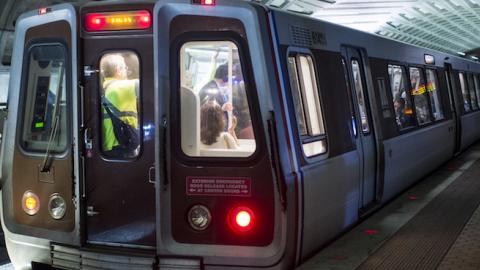In ten years, will anyone ride the Washington Metro? That’s not as crazy a question as you might think. While New York’s Subway struggles with record crowding, Metro ridership is plummeting according to this report from WTOP:
Far fewer people are riding Metro over the first half of Metro’s budget year, a drop that is much steeper than the last several years of rider decreases and is contributing to a projected $125 million revenue shortfall for Metro by the budget year’s end in June.
Combined rail and bus ridership is down nine percent over the same time period one year ago, a drop of 16 million trips; rail ridership is down 12 percent. Compared with the peak in 2009, rail ridership is down by well over 100,000 trips each weekday.
Metro had forecast a ridership increase in its budget despite a trend of years of declines, so the financial impact is even more significant, with projections now calling for $921 million in net subsidies from Maryland, Virginia and D.C. compared with the $845 million agreed to under the budget approved last March.
There are many reasons for the decline, but one of the obvious ones is that Metro’s trains have more delays than ever, and the system has been plagued by bad press thanks to fires in the tunnels and other mishaps. Trains not only take a long time to arrive; there’s a widespread sense that they’re not very safe. The politics of fixing Metro affordably is a huge challenge because of public sector unions and contractors that are hard to push aside. So it’s unlikely the system will get better without enormous taxpayer expenditures.
It’s tempting to think that spending the money, even a lot of money, is worth it. There are still many people who take Metro every day, and as the Washington region continues to grow in size and importance (largely thanks to the growth of the federal government and the lobbying industry) it is certain that more people will look for good public transportation. But will they want to take Metro even if (it’s an open question) the system is repaired properly?
There are reasons to think they won’t. Washington is small enough that many residents don’t gain much advantage from Metro. Most people live within two miles of their offices and spend about 25 minutes getting to work. Contrast that with a bigger city like New York, where people on average have 45-minute commutes and travel longer distances. In bigger urban environments, or for people who come into the city from the outskirts, trains make a lot of sense and a hub-and-spoke transit map works. Taking a train from Friendship Heights (a DC suburb) downtown is easier, and often faster because of traffic, than a bus or a car or a bike. But as more people want to live in the middle of the urban core, the utility of metro systems in cities like Washington is called into question. Moreover, because Washington still isn’t very dense, most people have to walk pretty far just to get to the Metro station. If getting from home to the train takes fifteen minutes and the entire commute is only 25, it might make more sense to take a $3 Uber or Lyft ride share—or even to find a convenient bus.
And growing urban density is far from a given. Indeed, there’s plenty to suggest that, as time goes on, more people will move back out to the suburbs in most cities. As rents rise because supply can’t keep up with demand, millennials will learn the value of moving their families into a house with a yard and a garage. (Already, the suburbs are becoming the destination of choice for immigrant families and blacks who cannot afford to live in the urban core.)
But there are two big technological changes on the horizon that suggest Metro wouldn’t reap as many rewards from a DC re-suburbanization as it did when the system was constructed during the last big suburbs expansion:
The first is telework. Fewer people need to come into work every day, and this will only increase as video conferencing and collaboration tools improve and as professional norms adapt to new possibilities.
The second is self-driving cars. Right now, taxis are hampered by rising labor costs. But once you don’t need a driver, taking a ride share to work could be as cheap as the Metro. It’s already pretty close, although that’s partly because Uber and Lyft are sitting on ever-growing mountains of venture capital. But even after investor money disappears, self-driving cars will make ride-sharing a cost-competitive option, especially when you factor in the convenience of door-to-door service (or at least close to door-to-door service—ride-sharing company Via, for example, only picks people up on street corners to cut travel times.) Further into the future, one can imagine self-driving vehicles being so ubiquitous and safe that they can be designed with more commuter-friendly seating configurations. If accidents are as rare as initial projections suggest autonomous technology can make them, road vehicles will be redesigned.
Between Metro’s inherent costs and inefficiencies, the likelihood of increased suburbanization in the short-to-medium term, and the promise of self-driving cars and telework in the medium-to-long term, it’s possible to imagine a time when no one will even need Metro’s urban transit system. The decline in ridership that we’re seeing today might turn out not to be blip, but a harbinger of a post-Metro commute. That future is not here yet, and emerging trends are not yet a reason to somehow abandon what is in place. But when budgeting for the future, ignoring fast-approaching realities is equally, if not more, foolish.
















